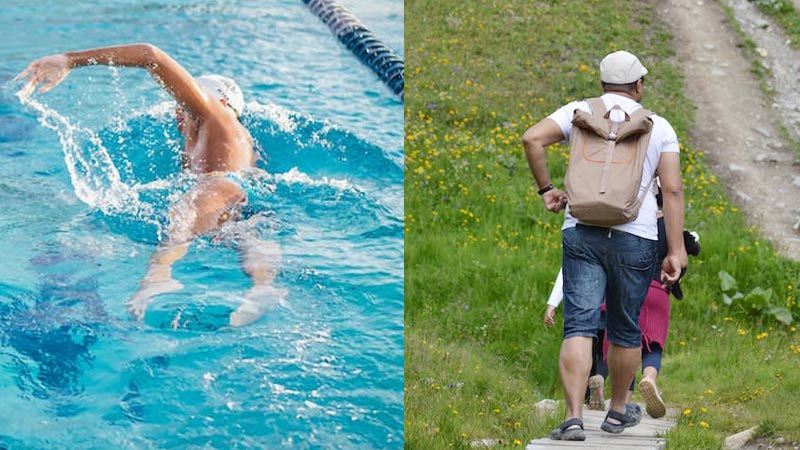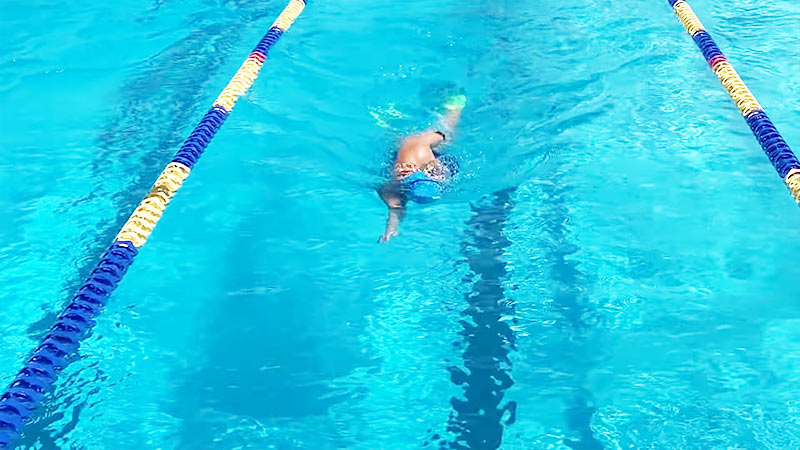In the perpetual quest for effective calorie-burning exercises, the debate between swimming and walking is a frequent contender.
Both activities offer unique benefits, but determining which torches more calories involves a nuanced evaluation.
Walking, a simple yet accessible exercise, treads its way into daily routines, while swimming, with its immersive resistance, dives into a full-body workout experience.
Understanding the nuances of these exercises, including intensity, muscle engagement, and sustainability, is pivotal in unraveling the calorie-burning mystery.
Exploring the comparative factors, such as duration, accessibility, and the impact on overall fitness, unveils the true champion in the battle for burning calories. So, stay focused.
Do You Burn More Calories Swimming or Walking?
When people are confused about walking Vs swimming, they ask, which burns more calories swimming or walking.
The number of calories burned while swimming versus walking depends on various factors like intensity, duration, and individual factors.
Swimming is a full-body workout engaging various muscle groups, potentially burning more calories than walking. It’s a highly efficient aerobic exercise, but the calorie burn can vary based on strokes and intensity.
Walking, while a less intense activity, can still effectively burn calories, especially if it’s brisk or uphill, engaging muscles in the lower body.
For a more precise comparison, factors such as speed, distance, stroke techniques in swimming, and the individual’s weight and fitness level need consideration.
Generally, swimming often burns more calories per minute due to the resistance of water, engaging more muscles.
However, both activities contribute to overall fitness and weight management. The best exercise is the one you enjoy and can sustain regularly.
The Case for Walking to Burn Calories

Walking offers several advantages when it comes to burning calories and improving overall health:
Accessibility and Sustainability
Walking is one of the most accessible forms of exercise. It requires no special equipment and can be incorporated into daily routines.
This accessibility makes it easier to maintain as a regular habit, which is crucial for consistent calorie burning and long-term weight management.
Consistent Calorie Burn
While walking may not have the intense calorie burn of some high-impact activities, its low-impact nature allows for longer durations.
This prolonged activity can result in a consistent and sustainable calorie burn over an extended period, contributing significantly to weight management.
Adaptability and Inclusivity
Walking can be adapted to different fitness levels and health conditions. Whether it’s a leisurely stroll or a brisk walk, it can be tailored to individual needs.
Its low impact also makes it an excellent choice for those with joint issues or injuries, allowing them to engage in calorie-burning activity without added strain.
Mental Health Benefits
Apart from burning calories, walking offers mental health benefits.
It’s an opportunity to clear the mind, reduce stress, and boost mood, which can indirectly support healthy lifestyle choices and contribute to overall well-being.
The positive mental effects might lead to better consistency in exercise routines, aiding in calorie burning and weight control.
The Power of Swimming to Burn Calories

Swimming is a powerful calorie-burning exercise with several distinct advantages:
Full-Body Workout
Swimming engages multiple muscle groups simultaneously, offering a full-body workout. Different strokes target various areas, such as the butterfly engaging the upper body or the breaststroke working the legs.
This comprehensive engagement burns a significant number of calories as it requires substantial energy output.
Calorie Burn Efficiency
The resistance of water amplifies the calorie burn, as you work against it with each stroke. This resistance makes swimming more energy-intensive compared to many other forms of exercise.
The continuous movement against the water creates a high-calorie expenditure, making it an efficient way to burn calories in a shorter time frame.
Low-Impact Exercise
Despite its intensity, swimming is low-impact, putting less stress on joints and muscles.
This makes it an excellent option for those with joint issues or injuries who still seek a high-calorie burning workout without the risk of impact-related injuries.
Increased Metabolic Rate
Intense swimming sessions can elevate the metabolic rate even after the exercise has ended.
This means the body continues to burn calories post-swim as it works to recover and repair, offering an additional benefit for overall calorie expenditure.
This post-exercise calorie burn, known as excess post-exercise oxygen consumption (EPOC), is particularly significant after intense swimming sessions.
Comparison: Swimming Vs Walking Calories

When comparing swimming and walking in terms of calorie burning:
Calories Burned per Hour
Swimming typically burns more calories per hour than walking. The exact number varies based on factors like stroke style, intensity, and the individual’s weight.
While walking is less intense, a brisk pace or uphill terrain can increase its calorie burn, yet it generally burns fewer calories than swimming due to the latter’s full-body engagement and higher energy expenditure.
Muscle Engagement and Impact
Swimming engages multiple muscle groups simultaneously due to the resistance of water, resulting in a comprehensive workout.
Conversely, walking primarily engages the lower body, making it less intensive but more accessible for individuals with joint issues or limited mobility due to its low-impact nature.
Consistency and Sustainability
Walking, being more accessible and easier to incorporate into daily routines, might lead to more consistent calorie burning over time.
Swimming, while effective, might be less convenient for many due to access to pools, changing facilities, and specific time requirements.
Intensity and Variation
Swimming offers various strokes and intensities that can significantly affect calorie burn.
High-intensity swimming sessions can rapidly increase calorie expenditure, while walking, though it can be brisk, may have limited variation in intensity unless integrated with uphill climbs or interval training.
The variety in swimming styles can make it easier to adjust workouts for varying fitness levels and goals.
Walking Vs Swimming Calories: Overview
When considering the comparison between walking and swimming in terms of calorie expenditure:
Calories Burned per Mile or Distance Covered

Walking a mile generally burns fewer calories than swimming the same distance due to the lower intensity. However, this can vary based on factors like speed, terrain, and individual fitness levels.
Swimming distances can burn more calories due to the resistance of water, though it may not be as easily quantifiable as walking in terms of distance covered.
Duration and Sustainability
Walking can be sustained for longer durations, making it easier to maintain a consistent calorie burn over an extended period.
Swimming, while potentially burning more calories per minute due to its higher intensity, might be limited by access to a pool and the physical demands of the exercise, affecting its long-term sustainability.
Impact and Accessibility
Walking is a low-impact exercise, making it accessible to a wider range of individuals, including those with joint issues.
It can be easily integrated into daily routines. Swimming, although a low-impact exercise as well, requires access to a pool and may have logistical barriers for many, impacting its accessibility.
Intensity and Calorie Burn
Swimming, with its full-body engagement and resistance from water, tends to burn more calories per hour than walking.
The calorie burn during swimming can range widely based on strokes used and intensity while walking’s calorie burn is generally lower but can increase with pace and terrain variations.
Muscle Engagement and Comprehensive Workout
Swimming engages multiple muscle groups simultaneously, offering a full-body workout. In contrast, walking primarily targets the lower body muscles.
This distinction makes swimming more comprehensive but also less accessible for those with limited mobility or joint issues, where walking might be a more viable option.
Variation and Adaptability
Swimming offers a wide variety of strokes and intensities, allowing for different workout options based on fitness levels and goals.
Walking, while less varied, can be modified by changing speed, incorporating hills, or even adding weight to increase intensity.
Mental and Physical Benefits
Both activities offer mental health benefits, but walking, with its ease and outdoor element, can provide a sense of relaxation and stress reduction.
Swimming, on the other hand, due to its immersive nature, offers a unique kind of relaxation.
Overall Body Engagement
Swimming engages multiple muscle groups simultaneously, providing a full-body workout, whereas walking primarily engages the lower body.
Comprehensive engagement in swimming can result in a higher calorie burn due to the increased energy output from using various muscle groups.
FAQs
What burns more calories swimming or walking?
Swimming generally burns more calories than walking. The exact number of calories depends on factors like intensity, stroke, and body weight.
A vigorous swim engages multiple muscle groups, making it a highly effective cardiovascular exercise that can surpass the calorie burn of walking.
Does swimming burn more calories than walking?
Yes, swimming tends to burn more calories than walking. The water resistance in swimming demands greater effort from muscles, leading to a higher calorie expenditure.
Additionally, the buoyancy of water reduces the impact on joints, allowing for longer and more intense workouts.
what burns more calories walking or swimming?
While walking is a beneficial low-impact exercise, swimming generally outpaces it in calorie burning. The water’s resistance provides a full-body workout, elevating the heart rate and calorie expenditure.
However, the specific calorie burn depends on the walking speed and swimming intensity.
What is better in calories burned by swimming vs walking?
Swimming is often considered better for calorie burning than walking. The dynamic nature of swimming engages various muscle groups, promoting a higher metabolic rate.
Moreover, the resistance from water increases the workout intensity, contributing to a more significant calorie expenditure compared to walking.
Is swimming better than walking?
In terms of calorie burn and overall cardiovascular benefits, swimming is often considered better than walking. Swimming engages the entire body, promoting muscle strength and endurance while being gentler on joints.
However, personal preferences, accessibility, and individual fitness goals should also be considered when choosing between the two.
Wrapping Up
In the swimming vs. walking bout for calorie incineration, there’s no singular victor. Each activity holds its unique advantages.
Swimming showcases its prowess in intense, full-body engagement, fostering a high-calorie burn per minute while walking’s accessibility and sustained duration contribute to consistent calorie expenditure.
The choice ultimately hinges on personal preferences, fitness goals, and accessibility.
Whether walking the scenic route or diving into the pool, both activities offer invaluable contributions to overall health and fitness.
The real win lies in finding the exercise that not only torches calories but also resonates with personal lifestyle and well-being goals. Best of luck.







